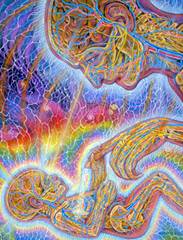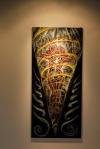Grey’s Anatomy
October 9, 2009 § Leave a comment
A few months ago when I stumbled upon the front page of Meta Gallery’s website, I was intrigued to see a painting of a father and daughter reading a book together. Charming, yes, except for the fact that they had veins and bones visible and depicted without skin. These renderings were like anatomical drawings in vivid form. It was from the exhibition currently on at the gallery by the artist Alex Grey, entitled Anatomy of Being. This bodily concept took me back to Gunther von Hagen’s Body Worlds exhibition at the Ontario Science Centre in 2005, which was thoroughly interesting and equally disturbing. I wondered if this exhibition would have the same effect on me.
A little uneasy at first, I tentatively began to look around, and discovered very quickly Grey’s meticulous attention to detail. His acrylic and oil paintings are fascinating in terms of his minute depiction of intricate patterns and medical detailing that seem as though they were created with computer graphics. However, his pencil studies show that surely these are the work of his hands. His images are incredibly three-dimensional and they make you tilt your head, squint your eyes, and move back and forth in front of the paintings. The visual aspect of his work is so engaging that you will forget that they are two-dimensional. Combined with the brilliant colours and elaborate rhythmic patterns, it makes for an interesting visual phenomenological experience.
At my own discretion, I chose to group Alex Grey’s paintings into a theme, which I chose as Love. Grey depicted different kinds of love such as physical, familial, intellectual, and divine. By anatomically portraying this variant theme of love, Grey materialized it and presented the theme as a tangible thing that we not only feel but can also see and touch.
 We often talk about chemistry between two lovers such as butterflies in your stomach when kissing or sparks flying amid an intimate embrace. The artist captured just that with some aspects of his work and depicted the physical state of the lovers and of love itself. In Tongues of Fire, a couple can be seen engaged in the open act of French kissing. Pietro Bembo, who was a Renaissance scholar, once defined kiss as the ultimate expression of spirituality and a union of body and soul where each persons’s soul was transported into one another and left to mingle in an intense state of passion.
We often talk about chemistry between two lovers such as butterflies in your stomach when kissing or sparks flying amid an intimate embrace. The artist captured just that with some aspects of his work and depicted the physical state of the lovers and of love itself. In Tongues of Fire, a couple can be seen engaged in the open act of French kissing. Pietro Bembo, who was a Renaissance scholar, once defined kiss as the ultimate expression of spirituality and a union of body and soul where each persons’s soul was transported into one another and left to mingle in an intense state of passion. It looks like Grey is right on Bembo’s idea in depicting a strangely blissful aura exuding in and around the two heads. In another painting Love is a Cosmic Force, a couple is occupied in what can be perceived as sexual intercourse. The woman and the man each harbour a planet, and in the act of making love, another planet is created in the uterus. A cosmic force radiates from the centre of the painting and surrounds the pair in a multicoloured haze. There we have it, love is in the air, in their veins and in their pumping hearts.
It looks like Grey is right on Bembo’s idea in depicting a strangely blissful aura exuding in and around the two heads. In another painting Love is a Cosmic Force, a couple is occupied in what can be perceived as sexual intercourse. The woman and the man each harbour a planet, and in the act of making love, another planet is created in the uterus. A cosmic force radiates from the centre of the painting and surrounds the pair in a multicoloured haze. There we have it, love is in the air, in their veins and in their pumping hearts.
 Grey also presents us with Reading and Young and Old that depict a parental figure and a child communicating with each other in close proximity. In Young and Old, a baby grabs the finger of what might possibly be a grandparent and makes eye contact. Again, we are moving beyond the actual physical contact and Grey stunningly portrays a visually spiritual bond between the two that emanates from the man’s finger and extends to the infant’s heart in a glowing, permanent, and unbreakable manner.
Grey also presents us with Reading and Young and Old that depict a parental figure and a child communicating with each other in close proximity. In Young and Old, a baby grabs the finger of what might possibly be a grandparent and makes eye contact. Again, we are moving beyond the actual physical contact and Grey stunningly portrays a visually spiritual bond between the two that emanates from the man’s finger and extends to the infant’s heart in a glowing, permanent, and unbreakable manner.
 The image named Reading may also fall under my intellectual category, since the father and daughter are reading from a book. The father whispers a passage from Blake’s poem, Tyger, into the daughter’s ear while their gazes are fixated on the pages of the open book. While both of their brains are firing off what could be portrayed as neurons, a portrait of the author emerges out of the daughter’s brain.
The image named Reading may also fall under my intellectual category, since the father and daughter are reading from a book. The father whispers a passage from Blake’s poem, Tyger, into the daughter’s ear while their gazes are fixated on the pages of the open book. While both of their brains are firing off what could be portrayed as neurons, a portrait of the author emerges out of the daughter’s brain.
A similar representation of thought processing can be seen in Beethoven who is portrayed furiously composing amidst fiery musical brainwaves radiating out of his head. It was intriguing to see non-material forms such as a whisper, a thought, or a musical inspiration, emitting from each individual like an abstract aura.
 In my favourite aspect of the exhibition, there was an outlandish anatomical depiction of a woman floating upward within an upside-down cone surrounded by a strange energy. It immediately reminded me of countless Renaissance representations of the Assumption of the Holy Virgin Mary such as Titian’s Assunta. The more I looked at this image, the more I became certain that this indeed was a depiction of Mary’s Ascent into heaven, although the painting is untitled. Many Renaissance artists had depicted Mary rising heavenward with serene colours and mysterious lighting to create a sense of the divine, but here Grey has provided the viewer with a peak into Mary’s physical state while in spiritual ecstasy. Mary is not shown as an idealized female beauty with graceful garments and putti, but is stripped of her external appearance, and appears as the Holy Mother replete with a pumping heart and blood flowing through her veins.
In my favourite aspect of the exhibition, there was an outlandish anatomical depiction of a woman floating upward within an upside-down cone surrounded by a strange energy. It immediately reminded me of countless Renaissance representations of the Assumption of the Holy Virgin Mary such as Titian’s Assunta. The more I looked at this image, the more I became certain that this indeed was a depiction of Mary’s Ascent into heaven, although the painting is untitled. Many Renaissance artists had depicted Mary rising heavenward with serene colours and mysterious lighting to create a sense of the divine, but here Grey has provided the viewer with a peak into Mary’s physical state while in spiritual ecstasy. Mary is not shown as an idealized female beauty with graceful garments and putti, but is stripped of her external appearance, and appears as the Holy Mother replete with a pumping heart and blood flowing through her veins.
Through the exhibition, Alex Grey sought to visually materialize and give form to abstract themes, suggesting that such themes as love, intimacy, and spirituality are tangible and visible, exuding out of each and every human being. What seemed scary and uncanny at first could now be viewed as beautiful and mysterious, just like love.
Seowon Bang
Alex Grey: Anatomy of Being ran from June 26 to September 4, 2009 at the Meta Gallery.
Pictures courtesy of http://metagallery.com/exhibitions/8/anatomy+of+being/artworks/
Leave a comment